DISCLAIMER
There are inconsistent findings between the cited studies in this blog post, regarding the results of the dream-lag and day-residue effects, due to different approaches and study participants. There is also only one study that slightly resembles polyphasic sleep (but in the form of interrupted monophasic sleep).
It is necessary to keep a healthy amount of skepticism with regards to how polyphasic sleep changes the dreaming experiences of an individual, especially those who have adapted to a polyphasic pattern.
Introduction
There are a lot of unknown mechanics about how the brain works and how dreaming is involved with several processes. As such, a lot of dreaming phenomena remain unexplained, especially in the context of polyphasic sleeping. Aside from intensely vivid dreaming and lucid dreaming experiences, dream content interpretation is also a fascinating topic to look into.
This blog will collect data from 42 polyphasic sleepers in the community as part of the survey for the day-residue and the dream-lag effects. Both of these dream effects are relatively novel concepts in the community, despite being around for a long time with certain sleep studies. The focus of the blog includes:
- Breaking down the mechanics of these two dream effects
- Delivering some dreaming experiences from polyphasic sleepers to observe differences between dreaming on polyphasic sleep and monophasic sleep.
Content
- Day-residue Effect
- Dream Lag Effect
- Assessment of Dream Contents with Two Dream Effects
- Analysis of Surveyed Dream Contents
Dream Elements of the Dream Lag & Day-Residue Effects
Day-Residue Effect
This dream effect is the immediate incorporation of normal, pre-sleep waking experiences into dreams that often occur in the following night or within the same day1,2,3. Sigmund Freud originally postulated this dream effect; it is possible to find a contact point in a dream with experiences of the previous day. This process also has a tie with repression.
Currently, the day-residue effect is a widely common dream effect thanks to its ubiquity and abundant research support.
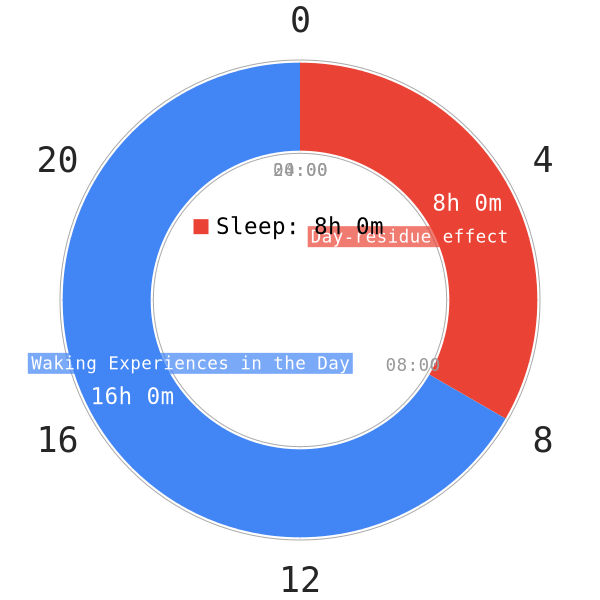
Formation factors
Despite its commonness, the day-residue effect seems to have varying incorporation degrees depending on 3 factors. These include sleep pattern1 (subtle hints), waking experiences1,3,4 and memory availability4. The data rules out individuals who cannot recall dreams upon awakening, or cannot remember sufficiently clear details of their dream contents. Sigmund Freud’s theory of dream incorporation suggests that all dreams reveal a contact point with the prior day’s events1.
Sleep pattern
The first study’s dream reporting occurred in the last cycle of REM sleep with a single dream and a single daytime event. Thus, the incorporation capability of the prior daytime events was low; the study also hints that having multiple dreams per night will drastically increase the incorporation rate1.
Polyphasic sleep does offer to split the main monophasic sleep block into smaller sleep blocks; therefore, a Dual Core pattern, for example, with two core sleeps likely results in more recalling of the previous daytime events.
Experiences during wake hours
Waking experiences that include personally important events rather than neutral or suppressed events also favor faster dream incorporation1. However, this mileage varies from person to person. Different dream reports also indicate the possibility of unreliable or biased dream reporting in favor of events during waking hours that each participant experienced2.
However, personally important events can be positive, negative, or neutral.
- Neutral experiences refer to normal daily life activities, which are familiar and mundane for the most part.
- In terms of emotions with successful dream recalling, subjects consistently recalled neutral items (and usually immediately after awakening). However, they did not recall positive emotional experiences4.
- There was also a favoritism for negative events more than positive events to a large extent; this result was contradictory to that of the first study4. However, a possible explanation for this phenomenon is stress and daily life concerns that each participant reflected. These experiences are more convincing than some willy-nilly experiences.
- Participants who were undergoing stress and difficult time overall are bound to recall dreams about their struggles.
- Given that dreams are generally easy to forget, especially when subjects did not pay attention, certain participants have a hard time recalling certain dream contents immediately upon awakening.
Memory availability
Memory availability is also a possible determinant that affects how long it takes for dreams to contain the details of previous waking experiences. Interestingly, over time, day-residue frequency would decrease for a specific type of memory3. The target memory in discussion is autobiographical memory; this consists of episodes from personal life, facts, worldview, perspectives, specific objects, sense of place, etc.
This type of experience seems to fit the dreams reports of the interviewed polyphasic sleepers.
- The recency effect mentioned in the third study states that incorporation of autobiographical memory decreases as time passes. This explains that the day-residue effect is most prevalent in the first night after the event happened earlier in the day3,4.
- The statistics also seem to support the one-day-residue effect more than the two-day-residue effect, which denotes waking experiences that incorporate into dreams the following night3.
Dream Lag Effect
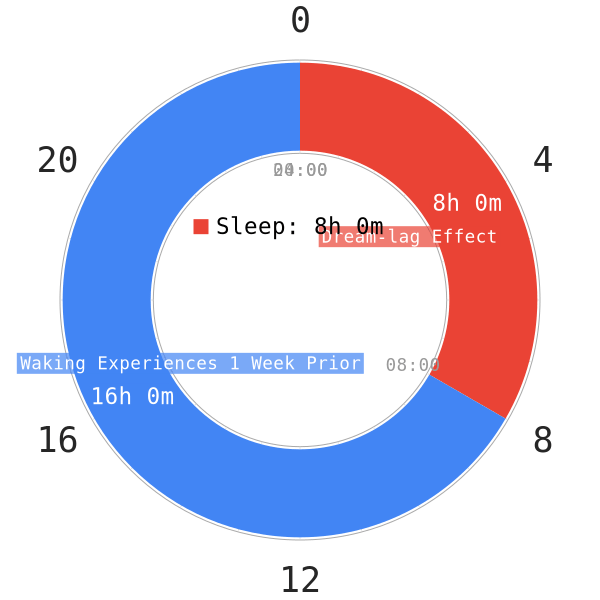
The dream-lag effect refers to the incorporation of materials into dreams from 6-8 days prior (average of one week)1. Contrary to the day-residue effect, there is a significant delay in dream incorporation, hence the “lag” effect.
The basis for the dream-lag effect’s existence stemmed from past animal studies where a remarkable transition from the hippocampus to the neocortex is a one-week process; the model of waking life-dream continuity was modulated in humans5. The dream-lag effect is still largely controversial, despite being under research in multiple studies from past to present.
Formation factors
Study Methods
For the most part, there is generally weak evidence that supports the dream-lag effect1,2,3,4,6, unlike its counterpart day-residue. A possible explanation is the methods of dream interpretation in each study.
- Studies that failed to replicate findings of the dream-lag effect used independent judges. These judges worked with each participant on their own to correlate dream contents and emotional elements in dreams with daily events.
- Using participants’ rating of dreams could re-simulate the dream-lag effect5.
- Few studies have been able to replicate the dream lag effects; however, the overall mechanisms behind this dream effect and what type of waking experiences would directly influence these effects are mostly murky.
Personally significant events
Similar to the day-residue effect, there are also particular types of daily life experiences that incorporate into dreams some time later. In a study with the largest number of participants, personally significant events, but not major daily activities or concerns had a correlation with the dream-lag effect7.
- This process was REM-sleep dependent when it comes to emotional memory consolidation; this opens up the possibility that major daily concerns or activities undergo REM sleep memory consolidation.
- Daydreams supported the day-residue effect, but not the dream-lag effect. This observation is also in line with daily concerns’ incorporation6.
- However, all these data sets only applied to monophasic sleepers with normal sleep patterns; whether it is applicable to an adapted polyphasic sleeper is unknown.
- It is also unclear if the dream-lag effect can come from NREM sleep (typically NREM2), although most speculations point toward REM sleep8.
Slow wave sleep & polyphasic schedules
Although SWS also consolidates memory, one study concludes that REM sleep is still responsible for consolidating certain types of waking experiences that result in the dream-lag effect9.
- The reason is that REM sleep, but not SWS or NREM2, strongly activates some brain regions. Such areas include the amygdala, tegmental regions, striatum and extended limbic cortical regions9.
- A polyphasic sleeper can reasonably experience the dream-lag effect during a sleep block with either predominantly REM sleep or ends with some REM period before awakening. Examples include the second core of a Dual Core schedule, or a first/second nap(s) of an Everyman schedule.
- However, there is a current concern with REM baseline. Not retaining the amount of REM sleep baseline as on their normal monophasic baseline would hinder the encoding process of such daily life experiences. Additionally, it may even suppress the dream-lag effect. Whether this suppression would affect memory capacity, consistently failing to meet daily REM sleep requirements is an alarming sign for future memory failure.
- It is then necessary to end adaptation because prolonged sleep deprivation (e.g, oversleeping syndrome) only leads to more damage in the brain system and functions.
Specific dream contents
In one 2-week study on dreaming experiences and interrupted monophasic sleep, a female participant was instructed to wake up once after 2h sleeping to record and log her dreams once every 2 days. The other alternate day was uninterrupted monophasic sleep, to sleep until morning. There were some delays of certain dream elements, yet the evidence was not strong.
- Emotions appeared in dreams 1.5 days after she experienced them
- Events and objects took 3.4 and 3.5 days on average respectively to appear in her dreams10.
- No dream elements took ~7 days to occur in the dreams.
This may give some insights into how polyphasic sleeping, a “broken” sleep regime by mainstream scientists, but not interrupted monophasic sleep in essence, can deliver such experiences. However, the study only contained one participant; thus, the data variance is likely considerable if a lot of participants had joined the study.
Assessment of Some Polyphasic Dream Contents With Two Dream Effects
Survey Background
Because of the novel concepts of both these dream effects, out of the surveyed 42 adapted polyphasic sleepers, only 9 subjects qualified for observation. The goal is to find out if they experienced either dream effects or both.
The chosen sleepers reported frequently recurrent dream contents on a consistent basis. This goes despite their adaptations ending a long time ago before this survey. The other subjects might or might not have experienced either dream effects because they could not remember their dreams specifically.
Survey Results & Notes
- The bigger majority (32 sleepers) agreed to have experienced the day-residue effect at least multiple times on their adapted schedules.
- The remaining 10 were either uncertain or could not remember sufficient details.
- However, only a small minority experienced the dream-lag effect; still, the lag was usually 3-5 days following their daytime experience rather than 7 days.
- About 27 sleepers considered themselves at least decent dream recallers.
- All of the dream reports were from home.
- Napcharts are also available in the case of non-standard polyphasic scheduling.
Day-residue Effect
Dual Core 1
“I don’t recall this lag being so long though. One example I have is this: There was a girl I was super into that I was just friends with. The day after I spoke to her, I had a dream about us sitting there holding hands. Whenever I want something very badly, I do have dreams about it.Or several times I have quit cannabis. When I have abstained for a while, I will have dreams about getting high. Basically whenever my brain seems to want something really badly that it cannot have. I have certainly found the dawn core to have excellent dream recall. ”
– Thatfatdood on his DC1 experience.
NOTE:
- Thatfatdood’s dreams seem to reflect daily concerns or at least desires; yet these did not come true in reality.
- The repressed contents came in his dreams frequently.
- This experience supports the notion that daydreaming can be incorporated into dreams; this report also evidences the day-residue effect well, similar to a study in the previous section.
- The contents were also negative/neutral at best based on the reflection; this result also supports the conclusions in a study about dream contents’ personal evaluation7.
Dual Core 1-extended
First example
I had seen an Instagram photo of two friends whom I hadn’t seen for a long time. In my dream, I was walking to a place on foot and there was a chip shop on the way. And those who took my order were the two friends in question. I know I had a long conversation that I could have had with them in reality.
Second example
It was with my best friends that I see the limit every day, in my apartment. It was just like in real life except for a door that had nothing to do with it. I went through that door and a coke dealer was there. I took a rail of coke and then my friends reacted as if I had taken some in real life. Given my goals with business and sport, it encourages me a lot. They were a little disappointed and I woke up stressed because I was unmasked ahah.
I had many more and it was always physical people. They are very close friends or long time friends who marked me by a discussion or respect towards them. Never any negative people I didn’t like. Never any object that I have ever been in the past either. From time to time, places that are not necessarily important to me, I have asked myself, “why I dreamed of this place”.
Dreams after adaptation
As for my dreams after adaptation, they were more intense and I remembered more things.
- It was during my second core (06:30-09:30) where I had the most dreams, it was incredible.
- It seemed to last 6-7 hours when in reality I only slept for 3 hours.
- The best dreams I had were during this second core.
- Otherwise during my nap at 4pm, I almost didn’t dream, it was rare and during my first core (01:30-04:30), there were some nice dreams from time to time.
- When I saw a post on Instagram of friends that I hadn’t seen for a long time, or a discussion that I liked with a certain person or a character from a movie that I like, I saw them again in my dreams; but I confess that sometimes it was the same day that I dreamt about them and not 5-7 days later.”
– Jeazizi on his DC1-extended experience.
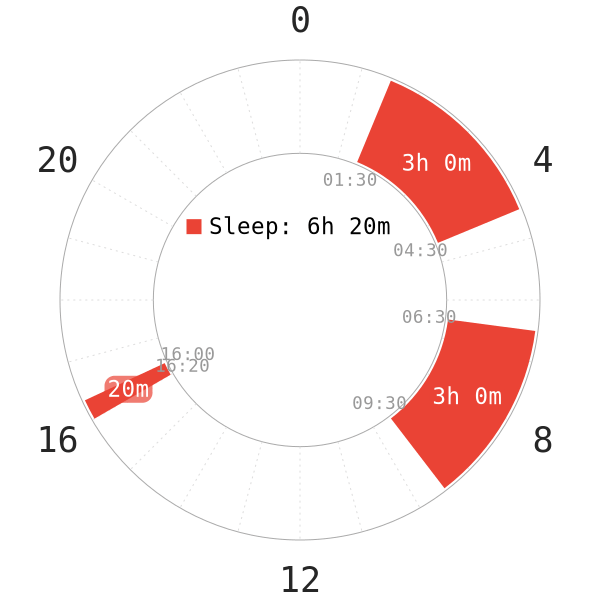
NOTE:
- Similar to Thatfatdood, Jeazizi’s second core of DC1-extended was a great sleep block for vivid dream recall and the day-residue effect.
- The second core was therefore the primary day residue thanks to the abundance of REM sleep and strong dream recall
- The first core also gave some dream recall from time to time.
- This DC1 variant was possible by the extension of the second core, bringing total sleep to > 6 hours.
Everyman 2
“Oh yeah definitely. Quite often actually, I almost certainly see people who’ve had a strong impression on me in my dreams. Sometimes even if I think about a person who had it quite a while ago and suddenly comes to memory, I likely will dream about them. Probably not in the immediate next naps, but next day or the day after.
I also have better dream recall on DC1 than on E2.”
– Erthiros on his E2 and DC1 experiences.
NOTE: Another example with daydreaming and thoughts/concerns during waking hours that can affect dream contents.
“I had some conflicts with my wife and we plan to divorce. Then that night, I dreamed that I applied to the court. Sometimes I dream about what I see on that day! Sometimes 1-2 days later. Not that long like 5-7 days.”
– JOY on his E2-shortened experience.
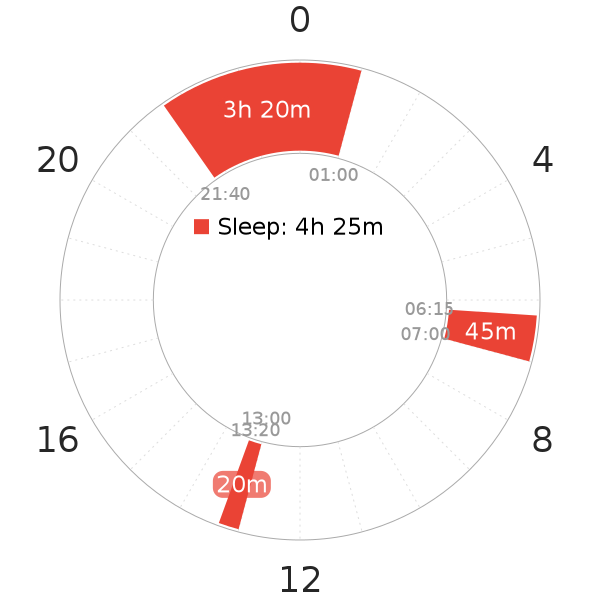
NOTE: Some major daily concerns or somewhat significant personal events that became parts of dreaming experiences later on.
Segmented
“I used to do a lot of boy scout activities during my adolescence. There was this challenge for 15-year-olds, three eagle feathers. Basically one feather stranded for one 24h challenge. First 24 h of silence, second 24 h of fasting and third 24h of solitude in forest.
Every time on that day when I had these trails, I had a very vivid dream with a theme where I failed the task. Spoke with someone, ate something and met someone while in the forest. Dreams manifested my fear of failing. To today, I consider them an important part of the challenge. This happened in the next sleep after some incidents.”
– Arteis on his Segmented experience.
Everyman 3-extended
“Yes I dream about things from real life. I will say it doesn’t always take 5-7 days. Something from yesterday was in my dream during the core.”
– Allyz0r on her E3-extended experience.
NOTE: This is an example of the two-day-residue effect, where incorporation into dreams took one day following the event that happened.
Everyman 3
“If I play a game, it usually takes a couple of days to get dreams playing the game. Other than that, sometimes relationship stuff… due to the lockdown the days are a bit fuzzy. So I don’t have much more present at the moment.
This happens quite a bit, yea. Sometimes sooner, sometimes longer, but it happens on a regular basis.”
– Corona on his E3 experience.
NOTE: Although the specifics of dates for this example were not clear, the delay of dream incorporation was not long enough to classify it as the dream-lag effect. It may be harder to remember dream contents when dreams were recurrent.
Biphasic-X
“Yeah, I had a patient that got worse under my care. I was not happy about that. And I was dreaming that her husband sued us. The whole team in the hospital blamed me and I had to go to prison.
The reality (event) happened on Thursday, the dream was the night after that.”
– S, a medical student, on her Biphasic-X experience.
NOTE:
The negative dream content was a result of personal worry and concerns of the medical student. This was during the time she had to take care of a patient whose conditions got worse; she had to be fixated.
- There was some long waiting for the direction for medication before administration. However, it turned out to be correct decision to not apply the medication for the patient.
- After a couple days and currently, the patient is in good condition and on the way to a full recovery.
- It was also S’ first experience handling a patient under the supervision of only the head doctor, so it was stressful.
- This left a strong impression on S; thus, it was considered a personally significant event to the degree that her dream reflected it.
- The dream occurred on the second night as a two-day-residue effect.
Dream-lag Effect
Biphasic-X
“This dream lag effect has happened a few times, I think. I’m not sure if this fits; but around last week I did a test at school. Around 3 days later I dreamed about doing the exact same test; however, this time I was really unprepared.The dream was very vivid and I remember pretty much all of it. I don’t think that dream lag effect ever happened on monophasic sleep.”
– Weaver on his Biphasic-X experience.
NOTE:
The lag effect did not match the original definition of 6-8 days on average; however, it is far enough from the day-residue effect to become a different type of dream incorporation.
Segmented/Dual Core 1
“Ok, this is really geeky and weird. I found out my favorite Esports team couldn’t play for a while because of COVID. On the day I’d normally watch them, I found out on Thursday and the dream was on Sunday or Saturday.”
– Jace on her natural Segmented & DC1 experience.
NOTE: Even though there was some kind of lag effect, the dream-lag effect overall was weak.
Bimaxion
“Core 1: I remember TV noises from the living room while I was in the bedroom doing nothing. Not sure if it’s real live TV noise slipping into my dreams cuz parents were watching a movie in the living room that night.
Core 2: A portion of contents from my own worldbuilding/story writing thing that I’ve been working on for many years. Some of the storyline in the dream was three days ago. I get these dreams a lot, and most of them are in first person experiences, and vivid.
Nap 1: Mostly sequences from shows and YouTube contents I’ve watched these past few days replaced or reenacted. But there were a few blanks in the middle that I can’t recall if anything happened. Either that or they were just void.
Nap 2: Me living at home alone minding my own business; however, there was no sign of anyone else ever living there with me. I live with four family members in real life.” – UncertainBeing on her Bimaxion experience (1).
My parents mentioned a few people from my childhood, so we spent an hour or so chatting about these old friends of mine and stuff that happened back then. And 6 days later, I had this dream where all of those people appeared. The setting of the dream was not related at all; nevertheless, some of the sequences were reenactments of old incidents involving these people that me and my parents in our conversation.
I don’t really dream about these people at all normally, I don’t even think about them unless something reminds me of them.”
– UncertainBeing on her Bimaxion experience (2).
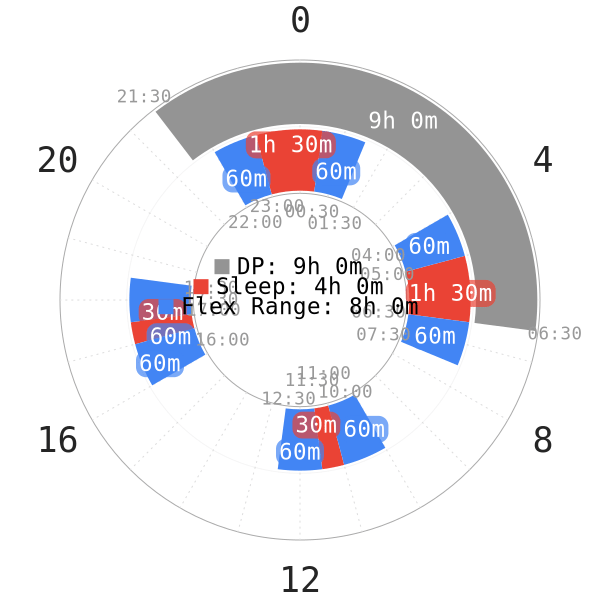
NOTE
Based on her recent dream log, the dream-lag effect occurred in the second core (around sunrise) and the second nap (around noon).
- Both these sleep blocks contain primarily REM sleep thanks to REM circadian being predominant around morning hours. This aids in strong dream recall.
- In the second experience however, the dream-lag effect reportedly occurred with the postulated delayed incorporation of 6 days.
- It is possible that certain personal experiences and unique encounters are subject to a slower incorporation.
Analysis
The limited data pool shows strong support for the day-residue effect but overall weaker evidence for the dream-lag effect.
- This seems to be in line with a lot of monophasic sleep studies where the day-residue effect is common but not the dream-lag effect. There does not seem to be any difference in polyphasic patterns that result in a possibly different outcome.
- Theoretically speaking, polyphasic sleeping allows sleepers to sleep more often than monophasic; thus, REM sleep is also observable across various sleep blocks accordingly; with this in mind, sleepers can recall very vivid dreams in a sleep block that is mostly REM-filled as shown in multiple cases.
- Because there is more dream recalling, the dream-lag effect is possibly suppressed when dreaming experiences from waking life turn into dreams.
- Multiple successful dream recalling incidents per day can effectively complete the memory consolidation process of encoding waking memories. This would lower the chance for the would-be dream-lag experiences to occur the following days.
More explanation for the dream-lag effect
It is also possible that polyphasic patterns with multiple sleep blocks each day (e.g, Everyman, Dual Core) can result in a weaker dream-lag effect than those with a long core sleep (e.g, biphasic).
- Using the same theory above, monophasic sleep usually gives difficulty remembering all dream details or a lot of dream elements and will take more time to incorporate certain waking experiences into dreams; this results in a stronger dream-lag effect in some studies mentioned in the previous section.
- The reported occurrence of a dream lag in the Bimaxion sleeper sparks interesting questions. How certain personally significant or unique events can result in a very delayed incorporation of dreams is unclear. In certain sleepers or polyphasic sleeping as a whole, the dream-lag mechanism may possibly be random like on monophasic sleeping.
- However, more support from more data of adapted polyphasic sleepers is necessary. They most likely have to log and report their dreams in the future to better determine the functions and availability of the dream-lag effect.
Conclusion
In sum, both the day-residue and dream-lag effects are interesting dreaming phenomena that can motivate dream logging in polyphasic sleep, especially those who are lucid/vivid dreamers. While both of these dream effects are different and seem to require specific waking experiences to produce them, the day-residue effect is more common than the dream-lag effect, even in the context of polyphasic sleep.
This sheds light on the continuity of waking-dreaming polyphasic sleep can preserve, even though personal dreaming experiences tend to vary. Some particularly important events, daily life concerns and daydreaming also play a part in formulating dream contents as well as creating certain delays in dream incorporation.
But still, more research is essential for polyphasic sleeping, dream report and dream interpretation to fully explore the dream-lag effect. All is for the hope that polyphasic sleep ideally will not lead to future memory degradation if done properly.
Main author: GeneralNguyen
Page last updated: 2 April 2021
Reference
- Nielsen, T. A., & Powell, R. A. (1992). The day-residue and dream-lag effects: A literature review and limited replication of two temporal effects in dream formation. Dreaming, 2(2), 67–77. doi:10.1037/h0094348.
- Henley-Einion, J. A., & Blagrove, M. T. (2014). Assessing the day-residue and dream-lag effects using the identification of multiple correspondences between dream reports and waking life diaries. Dreaming, 24(2), 71–88. doi:10.1037/a0036329
- Marquardt, C. J. G., Bonato, R. A., & Hoffmann, R. F. (1996). An empirical investigation into the day-residue and dream-lag effects. Dreaming, 6(1), 57–65. doi:10.1037/h0094446
- Veloce, Linnea F., et al. “The Effects of Emotional Salience on the Day-Residue and Dream-Lag Effects.” International Journal of Dream Research (2019): 62-69.
- Blagrove, M., Henley-Einion, J., Barnett, A., Edwards, D., & Heidi Seage, C. A replication of the 5–7day dream-lag effect with comparison of dreams to future events as control for baseline matching. Consciousness and Cognition. 2011;20(2):384–391. doi:10.1016/j.concog.2010.07.006. [PubMed]
- Van Rijn, E., Reid, A. M., Edwards, C. L., Malinowski, J. E., Ruby, P. M., Eichenlaub, J.-B., & Blagrove, M. T. Daydreams incorporate recent waking life concerns but do not show delayed (“dream-lag”) incorporations. Consciousness and Cognition. 2018;58:51–59. doi:10.1016/j.concog.2017.10.011. [PubMed]
- Eichenlaub, J.-B., van Rijn, E., Phelan, M., Ryder, L., Gaskell, M. G., Lewis, P. A., … Blagrove, M. The nature of delayed dream incorporation (“dream-lag effect”): Personally significant events persist, but not major daily activities or concerns. Journal of Sleep Research. 2018;e12697. doi:10.1111/jsr.12697. [PubMed]
- Blagrove, M., Fouquet, N. C., Henley-Einion, J. A., Pace-Schott, E. F., Davies, A. C., Neuschaffer, J. L., & Turnbull, O. H. Assessing the Dream-Lag Effect for REM and NREM Stage 2 Dreams. PLoS ONE. 2011;6(10). e26708. doi:10.1371/journal.pone.0026708. [PubMed]
- Van Rijn, E., Eichenlaub, J.-B., Lewis, P. A., Walker, M. P., Gaskell, M. G., Malinowski, J. E., & Blagrove, M. The dream-lag effect: Selective processing of personally significant events during Rapid Eye Movement sleep, but not during Slow Wave Sleep. Neurobiology of Learning and Memory. 2015;122:98–109. doi:10.1016/j.nlm.2015.01.009. [PubMed]
- Kookoolis, A., Pace-Schott, E. F., & McNamara, P. (2010). Dream content and memory processing: Dream lag effects within a single night and across several nights: A pilot study. Dreaming, 20(3), 211–217. doi:10.1037/a0020640.
